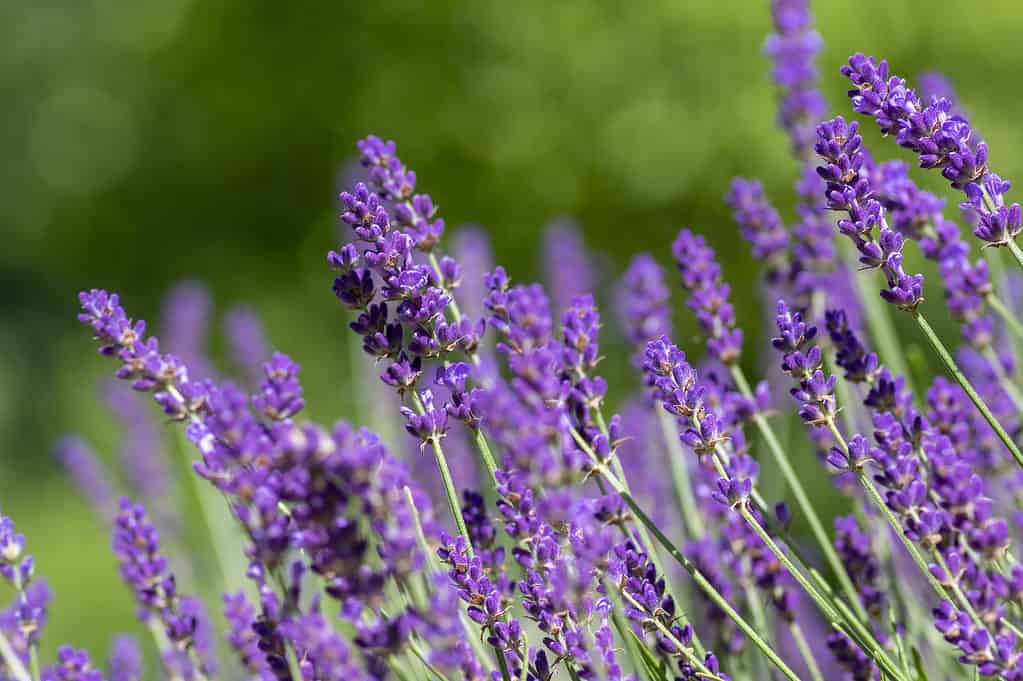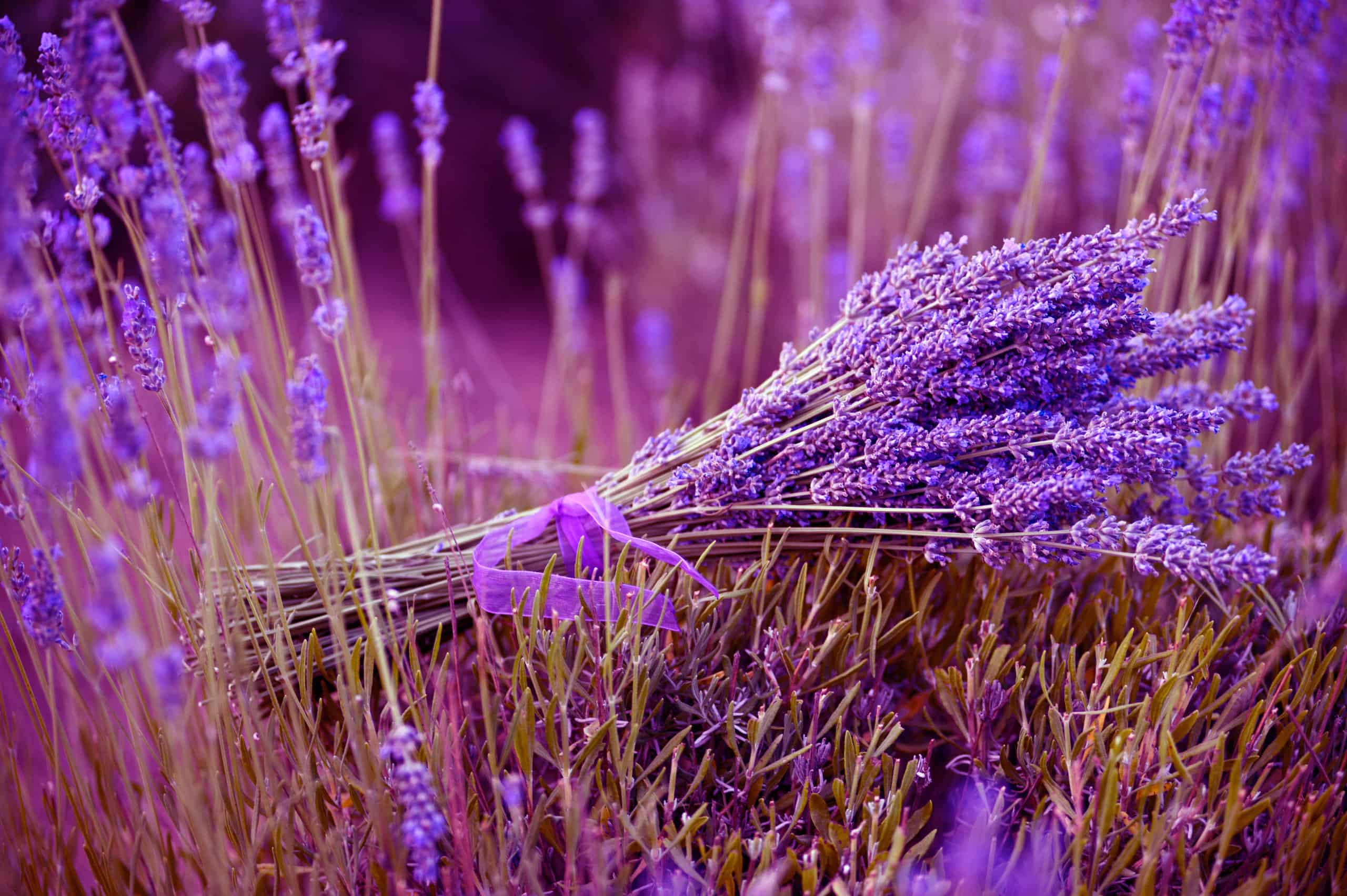The wonderful perennial plant lavender is a fantastic herb to use in your garden to entice butterflies, bees, and other pollinators to pay a visit. This native of the Mediterranean region is grown in gardens, commercially cultivated, and generally beloved as an ingredient in teas and dishes all over the world. They’re also notoriously easy to grow. You’ll be thrilled with the beauty and use of lavender plants in your yard if you decide to start growing this incredible (and pretty!) plant.
Let’s take a look at some fun facts about lavender, as well as some instructions on how to grow this plant in your garden or in a pot in your home.
The Botanical Name and History of Lavender
Lavender doesn’t refer to just one species. All of the plants in the genus Lavandula are often referred to as lavender interchangeably. However, the most common variety of lavender used for cooking, brewing tea, or simply as a garden flower is the species Lavandula angustifolia or English lavender.
A well-known and aromatic perennial plant, lavender has compact shrub-like growth, gray-green leaves, and tall flower spikes. The optimum time to plant lavender is in the spring after any chance of frost has passed and the ground has warmed up. It will grow gradually, usually gaining only a few inches in size per year.
Humans have been cultivating lavender for centuries. Lavender was cultivated and traded as a high-class and pricey plant by the ancient Greeks and Romans. It has been a component of spiced wine and other alcoholic beverages across Europe. It was brought to England in the 17th century and quickly grew in popularity there, where it was used often in jams, teas, and other foods. Nowadays, lavender is produced for commercial purposes all over the world and is a preferred herb for both cooking and landscaping.
Because the cultivated varieties of lavender are grown in gardens all over the world, they occasionally grow wild outside of their natural range. Although such unplanned expansion is often safe, certain Lavandula species have developed invasive traits.
There are over 47 different species of lavender, as well as a number of lavender varieties. English lavender, or Lavandula angustifolia, is one of the most commonly cultivated species. Lavandula x intermedia is a species that is popular for drying to place in floral arrangements. Lavandula dentata or fringed lavender is a popular shrub-like lavender species that is popular as a colorful landscaping bush. French lavender, or Lavandula stoechas, is commonly grown in Mediterranean regions.

English lavender (pictured) is the most common type of cultivated or commercially-grown lavender.
©iStock.com/Iva Vagnerova
Climate and Hardiness Zone Requirements for Lavender
Lavender can be planted in USDA hardiness zones five through nine. They need lots of sun exposure and tend to grow best in somewhat dry climates with mild winters and vibrant, warm summers. It’s a Mediterranean plant, so it tends to do well in moderate climates that average 70 to 85 degrees F consistently throughout the growing season.
When to Grow Lavender
The months of April and May are ideal for planting lavender since they are the first few weeks of spring. This allows the plant enough time to establish itself so that it can prosper during the summer. During this season, the earth also naturally warms up and provides the right temperature for lavender to grow. In general, though, lavender can be planted after the danger of frost has passed at the start of spring.
How to Grow Lavender
As with other plants, the success of your lavender garden will rely on the species or varieties you choose to grow as well as the type of growth circumstances you offer. Even if you follow all the instructions in this guide and your lavender plants seem content, the lavender plant’s genus is not known for its long lifespan and the majority of lavender plants will start to decrease after 10 years or less.
Keep in mind before you start growing lavender that it is mildly toxic to pets. If you choose to grow this plant indoors, be sure to keep it away from curious furry friends.
Soil and Fertilizer Requirements for Lavender
When it comes to choosing the right soil for lavender, go easy on the organic matter and fertilizer; lean soil, or soil with less organic matter mixed in, will foster a higher concentration of oils and fragrance from this plant. If you’re using a conventional potting mix, make sure to add some sand for drainage because lavender plants require well-draining soil that is on the drier side. Soil pH below 6.5 will probably result in your lavender plants being relatively short-lived, whereas an alkaline or very chalky soil can increase your lavender’s aroma and hardiness. When you initially start lavender plants, it’s a good idea to put a small amount of compost into the soil you plan to put your lavender plant in. After that, fertilizer feeding is not necessary for these plants and can reduce your lavender’s overall strength if done too often.
Water Requirements for Lavender
Once established, lavender is a hardy plant that is very drought tolerant. Give your lavender plants a lot of water during their first summer after being planted from seed. Following that, lavender can tolerate pretty severe prolonged droughts. Just as well, receiving too much water might result in fungal diseases and root rot.
Temperature and Humidity Requirements for Lavender
Lavender can survive a variety of temperatures, and excess humidity generally kills lavender plants more often than freezing temperatures do. Wet roots during the winter or excessive humidity throughout the summer are two examples of environments that will kill your lavender plants. If humidity is a concern, plant your bushes in a sunny place and leave enough space between each lavender plant to allow for ventilation. Plant lavender close to a stone or brick wall to give additional warmth and protection from the chilly winter winds. Your lavender plants will benefit from a layer of mulch to protect the roots if you live in a region where the ground has a tendency to freeze and thaw during the winter.

Lavender (pictured) can be grown commercially in areas with moderate temperatures similar to the Mediterranean.
©Kalina Georgieva/Shutterstock.com
Sunlight Requirements for Lavender
The best technique to ensure a large yield of buds and large, full bushes of lavender is to grow these plants in full, direct sunshine. If planted indoors, make sure your lavender plant has access to direct sunlight for up to six hours each day.
Pot Requirements for Lavender
Consider growing your lavender in a clay-based pot, as this material is breathable. Pots are a great option for growing lavender inside for the winter if outside cultivation is not doable. Growing lavender in a small area is preferable, so they do well in small pots. An excellent choice for a lavender pot is one that has a few extra inches to spare for the root ball; a container that is too big can encourage excessive dampness around the roots.
Make sure your pot has lots of drainage holes at the bottom since root rot is one of the few issues that lavender plants might encounter. Also, to help drain moisture away from the soil and prevent it from becoming too wet, you can grow lavender in a clay or terracotta pot. For planting, use a loose soil mixture and keep in mind that lavender grown in containers will need more water than plants grown in a garden. As a general rule, water when the soil seems dry, watering at the base of the plant to avoid wetting the foliage.
How to Harvest and Use Lavender
The fact that lavender flowers retain their scent after drying is a big factor in why it is so valued as a culinary herb and bouquet plant. Harvest the blooms as the buds first start to open for the best possible drying results. You should harvest your lavender using your hands or very clean scissors. They should be dried by being hung in little bunches upside-down in a warm area with excellent airflow and very low humidity. Lavender blossoms are not only lovely and fragrant, but they are also tasty. They can be used as a spice, baked into cookies, brewed into tea, eaten raw in salads, added to soups and stews, and much more. A little lavender flavor goes a long way, so use your harvested lavender carefully!
How to Prune Lavender
Despite the fact that lavender plants can be “pruned” on a daily basis by picking the flowers, spring trimming is advised to preserve your plant’s shape and to promote new development. While lower-growing varieties can either be trimmed back by a few inches or clipped down to new growth, taller lavender varieties can be reduced by around one-third of their height. If you reside in a region where lavender is susceptible to winter die-back, wait to trim your plants until you notice fresh green growth at the plant’s base. It’s doubtful that the plants would produce new growth if you disrupt them too early in the season.
Common Issues to Watch Out For
Several pests, including deer and insects, stay away from lavender because of its strong scent. Nevertheless, powdery mildew and other fungal infections can be an issue in humid areas. Plants should be spaced wider apart and should be placed in an area with sufficient air circulation to prevent the onset of fungus infections. As a result, the leaves will stay dry and be less vulnerable to fungus. In general, there aren’t many illnesses that affect lavender plants. They could get phytophthora, a fungus that lives in the soil and causes root and stem rot. Septoria leaf spot, which is a fungus that usually affects tomato plants, can also kill lavender plants.
Your lavender can also experience attacks from aphids, whiteflies, and spittlebugs on your lavender. Using a powerful stream of water from a hose to flush insects away from your garden lavender. Insecticidal soap sprays can also eliminate these pests without endangering animals, pets, or other beneficial insects and pollinators. Before the pests become a major problem, start spraying them off early. Other than that, your lavender will not attract very many non-beneficial insects.
What’s not to love about lavender? Not only is this an excellent herb to grow for culinary use, but it’s a beautiful plant that can add a vibrant pop of color to any outdoor or indoor space. If you want to start growing your own lavender, this plant only needs a little bit of TLC to thrive.
Thank you for reading! Have some feedback for us? Contact the AZ Animals editorial team.








